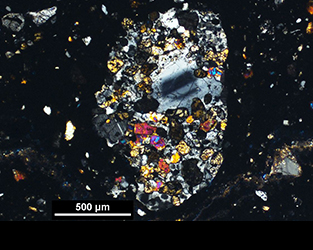Mars rocks date the start of our solar system's biological clock

Meteorite Material
It is easy to take for granted the static nature of rocks. On Earth, they make up the seemingly immovable mountains and canyons that long predated our existence, or indeed even earthly life. But as the planets formed, the diverse rock structures that became the crusts of Earth and Mars were in flux, driven largely by heavy asteroid bombardment of the inner planets as they accreted the rocky remnants following the birth of the Solar System 4.56 billion years ago. Impacts of the bombardments cannot be understated; planetary surface temperatures reached into the thousands of degrees Celsius and shock pressures were over a million times current levels. As molten rock cooled and minerals began to form, the evidence of surrounding temperature, pressure, and gases were locked into certain crystal structures, preserving a snapshot of early planetary conditions which can still be deciphered today, billions of years later. These snapshots, however, can continue to change in response to significant impact events, creating a running record of the planet’s history. As the magnitude and frequency of bombardment subsided, the surface of our own planet became habitable for the earliest forms of life – extremophilic bacteria adapted to high but decreasing temperature and pressure.
But what of Mars? Until now, we have had scant knowledge of the timing of the end of the bombardment period because rocks old enough to tell us have yet to be found on Earth. The time window of habitable conditions on Earth and our inner planet neighbours remained wide, imprecise, and hotly contested – until the 2013 discovery of a meteorite on Earth, originally from Mars. Mars’s topography is characterized by a sharp hemispheric dichotomy: one portion is largely flat and smooth with a thin crust while the other, older part, is made of dramatic rocky highlands and a thick crust. It has long been proposed that a cataclysmic impact caused this dichotomy, however, the resulting release of energy would have been more than sufficient to erase life from the planet. This means that only after this purported planet-altering impact could stable conditions of habitability on Mars have arisen, however estimates of the advent of these requisite stable conditions vary by almost a billion years.
Investigating this question has been vexed by limited access to Martian rock on Earth. So far, the only physical pieces of Mars in human possession are in the form of meteorites ejected from the planet following a significant impact. These prized rocks can yield incredible information about the enigmatic geologic history of our most similar planetary neighbour. Desmond Moser and his research group in the Departments of Earth Sciences and Geography have led an international team that has made a ground-breaking discovery about the beginnings of habitable conditions on Mars. By analyzing the most ancient known planetary minerals in meteorites from the Martian highlands, the Moser group has found that none of the crystal structures were exposed to pressures exceeding the upper limit of what is survivable by extremophilic bacteria. The crystal structures studied were all at least 4.4 billion years old, meaning that cataclysmic impacts on Mars ceased before the minerals formed.
Coupling their findings with pre-existing geochronology data, the Moser group has been able to place the occurrence of the Martian planet-altering collision at about 4.51 billion years ago – roughly coinciding with another massive collision with Earth that formed our Moon. This period was followed shortly thereafter by the beginning of habitable conditions on Mars. As the period of heavy bombardment ended, shock pressures remained low enough to prevent the shearing of cell walls and temperatures cooled enough for water to form. Moser’s group proposes that the giant impact with Mars may even have accelerated the release of early surface waters from the interior of the planet, to set the stage for life-forming reactions. The group’s key findings place the window for habitable conditions on Mars to be between 4.2 and 3.5 billion years ago, predating the earliest signs of life on Earth by up to 500 million years. Moreover, the bombardment of Mars is believed to be part of a solar-system-wide event, and this early date for the start of our solar system’s biological clock can also be applied to our own planet, such that the emergence of Earth’s collective family tree may well reach the greatest depths of our planetary chronicle.

